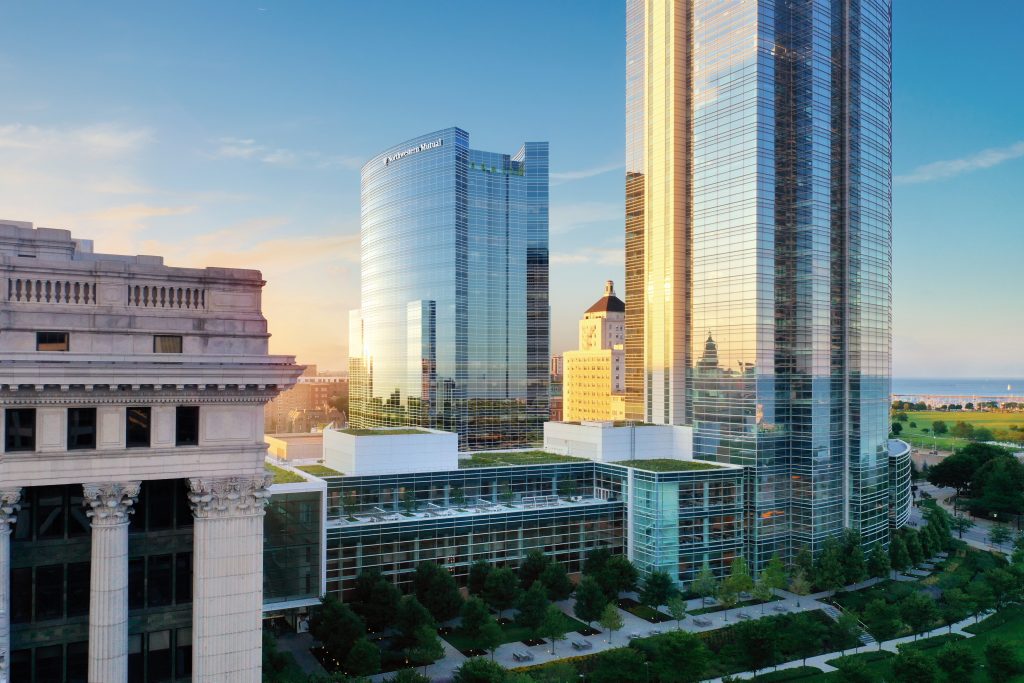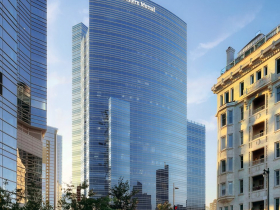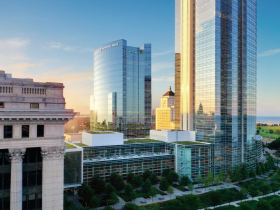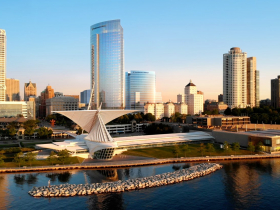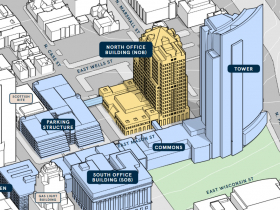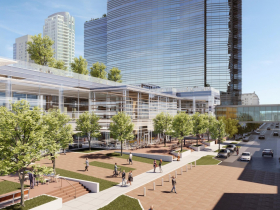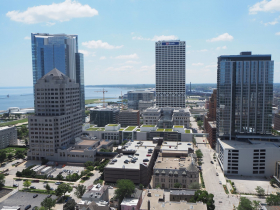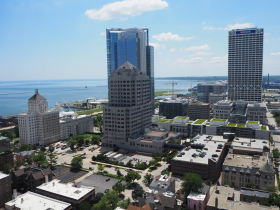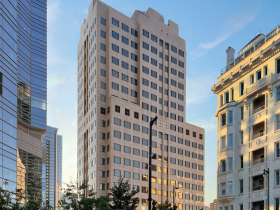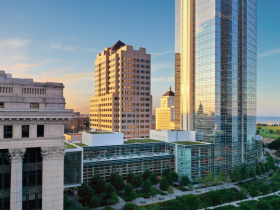City Board Endorses $30 Million For NM’s $500 Million Tower Project
Subsidy also includes $10 million for bike, park and street improvements.
Northwestern Mutual‘s proposal to completely overhaul its 18-story North Building into a smaller version of its 2017 office tower received its first public endorsement Thursday afternoon. The company would shutter its suburban Franklin campus as part of the agreement, creating a downtown campus with at least 5,750 employees.
The city is to provide $30 million to the insurance company in exchange for it redeveloping the tower, 818 E. Mason St., with a glassy facade and modern interior and growing its employee base. The city will also dedicate $10 million of increased tax revenue from the development towards public infrastructure improvements, including new protected bike lanes, redesigning a major intersection and improving Cathedral Square Park and Juneau Park.
“We are happy to report 10 years later, by almost any measure, we think that project exceeded expectations,” said Steve Radke, head of the insurance company’s government relations team and foundation to the Redevelopment Authority of the City of Milwaukee. That includes a shift in attitude towards Downtown, creating jobs for more than 800 city residents through the tower’s construction, developing the unsubsidized 7Seventy7 apartment tower and parking structure, the company outperforming employment benchmarks to earn the initial $54 million subsidy and the complex being assessed at greater than expected values, shortening the payback period.
Department of City Development economic development specialist Dan Casanova confirmed the tower’s strong performance. The subsidy agreement for the larger tower is ahead of schedule, and the company is exceeding a job target of 4,480 workers by having approximately 4,600 employees and contractors at its downtown campus. Approximately 25% of the company’s employees are city residents he said.
The steadily-increasing job benchmark, which expires at the end of 2030, currently maxes out at 5,375 employees. The new agreement would push it even higher, with 5,750 employees required starting in 2030. The company must hit the benchmark to be eligible for the full subsidy.
“When Mayor Cavalier Johnson talks about having one million Milwaukeeans, we need to continue to bring jobs closer to our residents,” said Casanova.
The company preferred the revitalized downtown building.
“Northwestern Mutual is and always has been a relationship-based culture,” said Rebecca Villegas, vice president of enterprise compliance and the project leader. The intention is to create a similar experience in both the 1990 and 2017 towers that would help attract and retain workers as well as make them more productive and collaborative. Designed by Pickard Chilton, the 2017 tower’s designer, the latest redevelopment would create a “consistent world-class experience no matter where you are on campus.”
Though it’s not required to hit the number to earn the subsidy, the company’s campus would have a combined capacity of 9,000 workers. Work could start this fall and be completed in 2027. It involves stripping the structure to its steel core and cantilevering additional floor space onto the structure.
“We believe this investment really sends a message to other companies in the region and throughout the country,” said Casanova. He noted that Milwaukee is bucking a trend away from downtown offices in the wake of the pandemic and has landed Northwestern Mutual, Fiserv, Milwaukee Tool, Software One and others.
The planned agreement would see Northwestern Mutual’s share of the city’s tax base continue to grow.
“Northwestern Mutual is 1.5% of the city’s entire tax base,” said Casanova. It would grow to 1.8% based on the city’s estimates. “While that’s a strength, it’s also a threat.”
The TIF district is effectively a property tax rebate, but only for 75% of the incremental revenue generated above the base value of $71 million. The district includes the North Building and the company’s parking structure at 777 N. Cass St. One block of N. Cass St., the stretch between the two properties, would be closed as part of the proposal, though the city must approve that and review the design through a separate legislative process.
A 23-year payback estimate is based on an estimate that the combined properties will grow from $71.8 million to $187.25 million in assessed value. If the properties fail to increase in value as expected, the company would see a corresponding reduction in its subsidy.
“The TIF financing is extremely necessary for us to be able to move forward with this kind of investment,” said Villegas.
As the subsidy for the initial tower is paid off, revenue from that development would return to the general fund of the city and the other property taxing entities. The revenue from the base value of both districts continues to flow to all of the property tax entities.
Renderings
Article continues below
Photos
Public Improvements
As state law allows, the city would expend the $10 million on a number of public improvements within a half mile of the district.
That includes extending the E. Kilbourn Ave. protected bicycle lane to N. Astor St. from N. Jackson St. It would also include “better protection” for the existing protected lane east of N. Water St., which is separated by plastic bollards and frequently has vehicles parked on top of it ($1 million). An additional north-south bike lane would be added from E. Mason St. to E. Kilbourn Ave. ($500,000).
Commissioner Bill Schwartz said the plans should include replacing the freeway on-ramp signage that has been frequently derided on social media for its confusing nature. “Agreed,” said Casanova, who noted city officials would return with a funding plan for the remainder.
The intersection of E. Kilbourn Ave., N. Astor St. and N. Prospect Ave. would be redesigned as part of the funding allocation ($1 million). The current version “really cuts off Downtown from Juneau Park,” said Casanova.
Juneau Park would also see upgrades, including lighting, building and landscape improvements ($400,000) and a wider Oak Leaf Trail segment from E. Mason St. down to the main trail at the bottom of the bluff ($250,000).
Cathedral Square Park would see its long-disused fountain removed and pathways rebuilt ($100,000).
The east side of N. Lincoln Memorial Dr. between the Milwaukee Art Museum and landing of the E. Mason St. bridge would receive a sidewalk, replacing a well-trodden desire path that signals the demand for such an improvement ($250,000).
A $500,000 public infrastructure contingency fund is also established to cover any potential cost overruns or scope changes.
Opposition and Concern
Two members of the public spoke about the deal: Marty Wahl and labor leader Peter Rickman.
Rickman, the president of the Milwaukee Area Service and Hospitality Workers Organization, said Northwestern Mutual has been a leader in hiring responsible contractors for janitorial services, but it could help improve the lives of everyday workers by improving conditions for food service workers.
Wahl criticized the amount of money going into Downtown.
“Regardless of all the work Downtown, the neighborhoods are struggling,” said Wahl. “You’re going to have traffic enhancements Downtown, what about us out here?”
He criticized the nature of the agreement that subsidized moving suburban workers Downtown. “We should not have to pay people to come into our city,” said Wahl.
Wahl, noting that The Hop is funded in part by parking revenue, said the streetcar’s operation is being paid for by poor Black residents paying overnight parking tickets for free transportation for white downtown workers. “Year after year, money is going Downtown, and it’s just not working,” he said.
Casanova previously stated that Downtown, despite covering only 2% of the city’s land area, generates a substantial amount of the city’s property tax revenue.
For The Birds
Commissioner Kathryn West praised the company for turning off its lights at night. “You can compare and contrast that to other buildings in the area,” she said. “I assume that’s a conscious effort.”
The glassy nature of the tower has drawn public concern over its impact on migratory birds.
“On the construction of the tower we actually retained an avian specialist to help us address that exact fact,” said Radke. He said design modifications included treating the glass and lighting changes.
He said the company plans to work with a specialist again on the North Building’s recladding.
“We actually regularly talk to our avian consultant,” said Villegas.
The board unanimously approved the agreement. The Common Council must still approve the agreement.
A copy of the TIF district proposal is available on Urban Milwaukee.
UPDATE: An earlier version had the wrong floor count for the North Building. It is 18 according to the company.
If you think stories like this are important, become a member of Urban Milwaukee and help support real, independent journalism. Plus you get some cool added benefits.
More about the Northwestern Mutual North Building Redevelopment
- See Inside Mutual Market, Opening Monday in East Town - Sophie Bolich - Nov 11th, 2024
- See Inside Downtown’s Biggest Construction Project - Jeramey Jannene - Oct 10th, 2024
- Friday Photos: Northwestern Mutual’s Unbuilding Changes Skyline - Jeramey Jannene - Jul 5th, 2024
- Convenience Store Coming to Northwestern Mutual Campus, Starbucks Moving - Sophie Bolich - Mar 14th, 2024
- Eyes on Milwaukee: Northwestern Mutual Makes ‘Skyline-Defining’ Bet On Downtown - Jeramey Jannene - Oct 3rd, 2023
- Eyes on Milwaukee: Northwestern Mutual Names Tower Team - Jeramey Jannene - Jul 11th, 2023
- Eyes on Milwaukee: Northwestern Mutual Wins Key Vote To Close Cass Street - Jeramey Jannene - Jun 29th, 2023
- Eyes on Milwaukee: Northwestern Mutual’s Glassy Second Tower Is A Go - Jeramey Jannene - Mar 21st, 2023
- Eyes on Milwaukee: Council Strongly Supports Northwestern Mutual Deal - Jeramey Jannene - Mar 14th, 2023
- Eyes on Milwaukee: City Board Endorses $30 Million For NM’s $500 Million Tower Project - Jeramey Jannene - Feb 16th, 2023
Read more about Northwestern Mutual North Building Redevelopment here
Political Contributions Tracker
Displaying political contributions between people mentioned in this story. Learn more.
- May 29, 2020 - Cavalier Johnson received $50 from Peter Rickman
- March 16, 2016 - Cavalier Johnson received $100 from Peter Rickman
Eyes on Milwaukee
-
Church, Cupid Partner On Affordable Housing
 Dec 4th, 2023 by Jeramey Jannene
Dec 4th, 2023 by Jeramey Jannene
-
Downtown Building Sells For Nearly Twice Its Assessed Value
 Nov 12th, 2023 by Jeramey Jannene
Nov 12th, 2023 by Jeramey Jannene
-
Immigration Office Moving To 310W Building
 Oct 25th, 2023 by Jeramey Jannene
Oct 25th, 2023 by Jeramey Jannene


